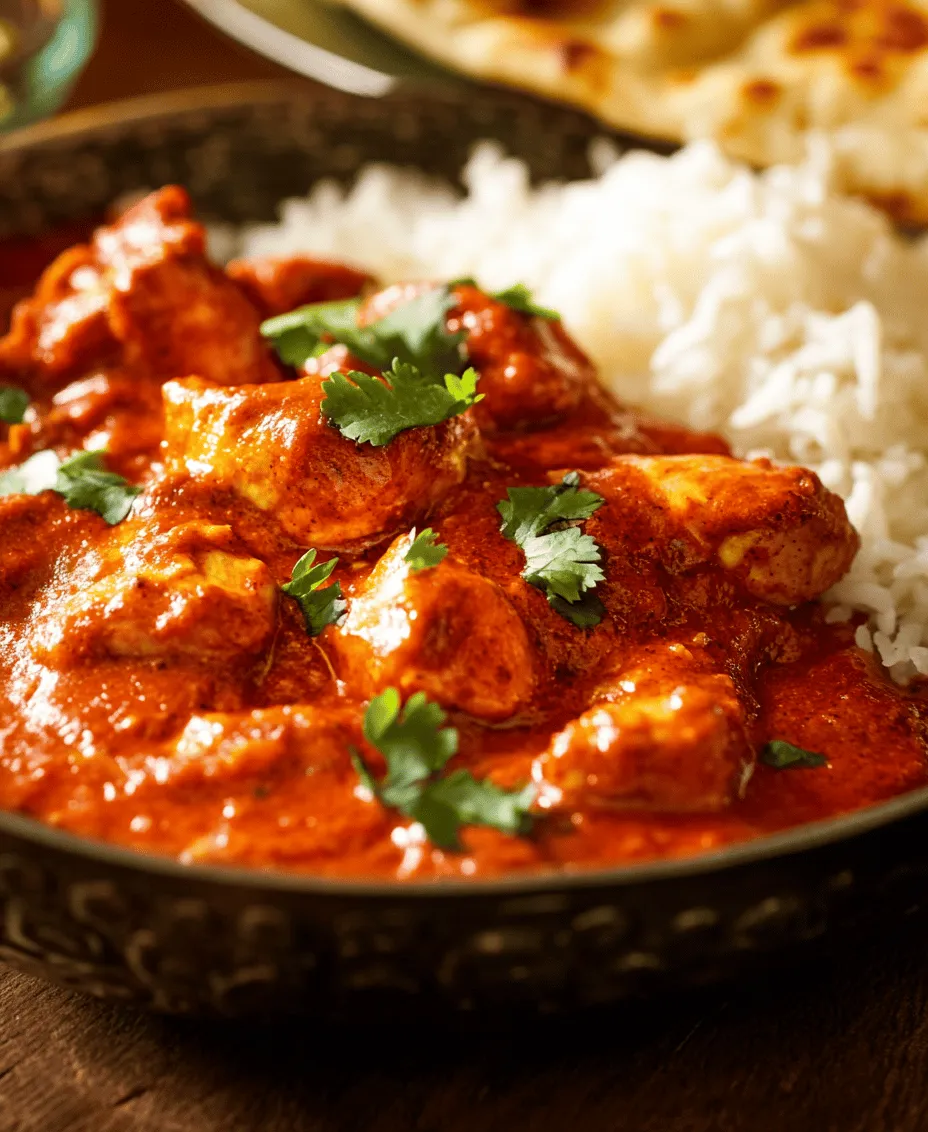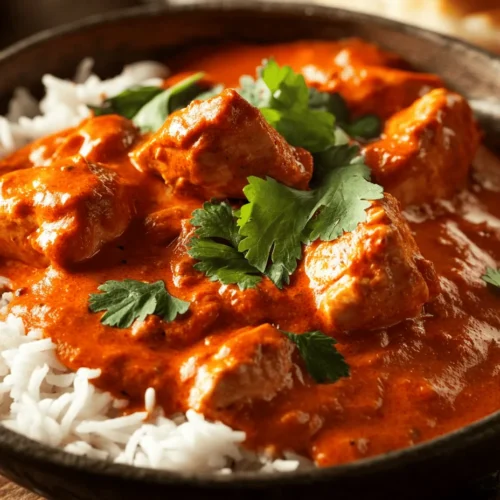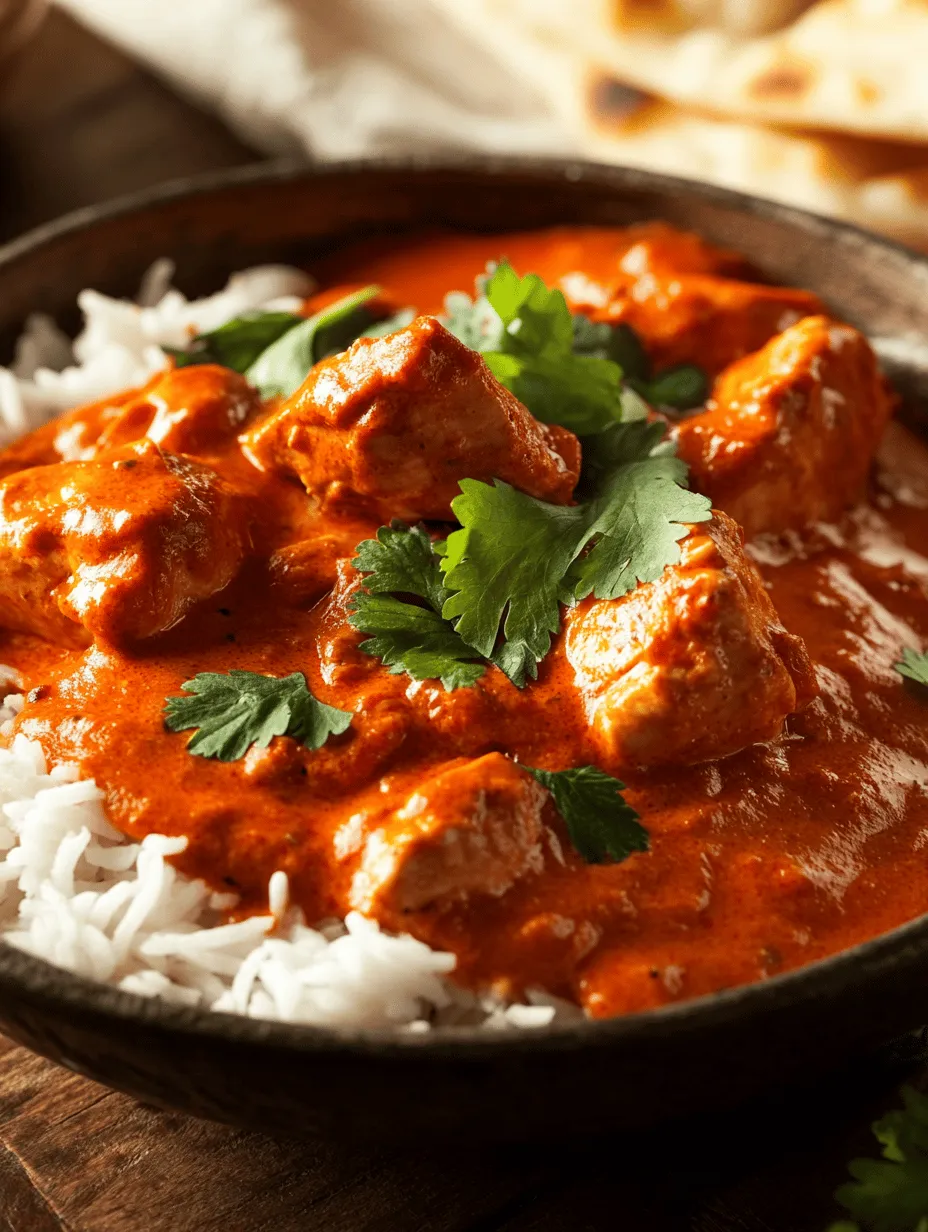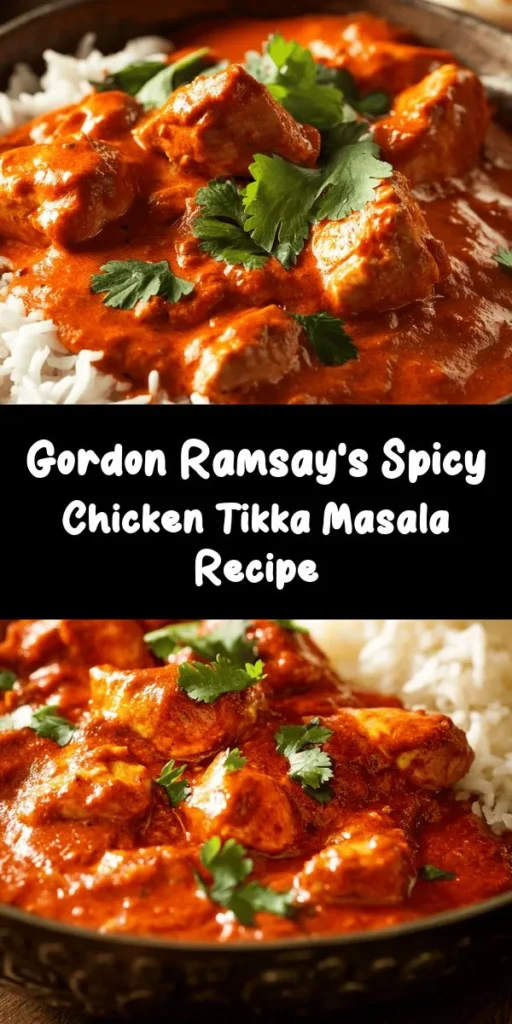Introduction
Welcome to a culinary adventure that will transport your taste buds straight to the vibrant streets of India. Today, we will be diving into the rich and aromatic world of Gordon Ramsay’s Chicken Tikka Masala—a dish that not only encapsulates the essence of Indian cuisine but has also carved a niche for itself in kitchens around the globe. Known for its tantalizing blend of spices, creamy sauce, and tender chicken, Chicken Tikka Masala is a beloved dish that strikes the perfect balance between heat and flavor, making it an enduring favorite among food lovers.
What makes this recipe particularly special is its accessibility; you can recreate the magic of a restaurant-quality Chicken Tikka Masala right in your own kitchen. With fresh ingredients and authentic cooking methods, this dish promises to elevate your dining experience. From the first whiff of the spices to the final bite, each moment spent preparing this dish will fill your kitchen with warmth and excitement.
Understanding the Essence of Chicken Tikka Masala
The origins of Chicken Tikka Masala are as diverse and intriguing as its flavors. While it is often associated with Indian cuisine, the dish’s exact roots are somewhat of a culinary mystery. Many food historians believe that Chicken Tikka Masala was born in the UK, specifically in the 1960s, when Indian chefs began to adapt traditional recipes to suit the palates of Western diners. This fusion gave rise to a dish that combines marinated, grilled chicken pieces with a rich, creamy tomato-based sauce, making it a staple in Indian restaurants around the world.
Culturally, Chicken Tikka Masala serves as a symbol of the evolving relationship between Indian and Western cuisines. Its popularity has led to various regional interpretations, with each cook adding their unique twist, whether it be through the choice of spices, the level of creaminess, or the method of preparation. This adaptability not only makes Chicken Tikka Masala a versatile dish but also a canvas for creativity in the kitchen.
Today, Chicken Tikka Masala is often considered a national dish of Britain, reflecting the deep-rooted love for Indian food in British culture. Its rise to fame highlights the dish’s ability to transcend cultural boundaries, making it a beloved meal enjoyed by individuals from all walks of life.
The Importance of Marinades in Indian Cooking
In Indian cuisine, marinades play a pivotal role in enhancing the flavor and tenderness of meats. For Chicken Tikka Masala, the marinade is not just a preparation step; it is an essential foundation that infuses the chicken with a symphony of spices. A well-crafted marinade can elevate the dish from ordinary to extraordinary, imparting depth and complexity to the flavors.
The marinade for Chicken Tikka Masala typically includes yogurt, which serves two primary functions. First, it tenderizes the chicken by breaking down its fibers, resulting in succulent, melt-in-your-mouth pieces. Second, yogurt adds a layer of richness that complements the spices beautifully. The longer the chicken marinates, the more pronounced the flavors become, making time an essential element in this process.
Additionally, the use of spices such as garam masala, cumin, and coriander in the marinade is crucial. These spices not only contribute to the dish’s signature flavor profile but also offer various health benefits. For instance, cumin is known for its digestive properties, while coriander is rich in antioxidants. By incorporating a flavorful marinade, you set the stage for an unforgettable Chicken Tikka Masala experience.
Ingredients Breakdown
Before embarking on the cooking journey, it is vital to familiarize yourself with the ingredients that will bring this dish to life. The Chicken Tikka Masala recipe can be broken down into two main components: the marinade and the tikka masala sauce. Each ingredient plays a unique role in achieving the desired taste and texture.
Chicken
For the chicken, thighs are often recommended over breasts. Chicken thighs are not only more flavorful but also retain moisture better during cooking, resulting in a juicier dish. They are less prone to drying out, especially when grilled, making them an ideal choice for Chicken Tikka Masala.
Yogurt
Yogurt is the star of the marinade. Not only does it tenderize the chicken, but it also contributes a creamy texture to the final dish. Opt for plain, unsweetened yogurt to maintain the integrity of the flavors. Greek yogurt can be a great alternative if a thicker consistency is desired.
Spices
The spices are what give Chicken Tikka Masala its distinctive character. Some key spices include:
– Garam Masala: A fragrant blend of spices that adds warmth and complexity.
– Cumin: Offers an earthy flavor, enhancing the dish’s aromatic profile.
– Coriander: Adds a citrusy note and is packed with antioxidants.
These spices not only enhance the taste but also provide health benefits, making your meal both delicious and nutritious.
Coconut Milk
While traditional recipes often call for heavy cream, using coconut milk is an excellent alternative that adds a subtle sweetness and a creamy texture without the heaviness. It is also a great option for those looking to make the dish dairy-free.
With these ingredients in mind, you are well on your way to creating a Chicken Tikka Masala that rivals any restaurant version.
Crafting the Perfect Marinade
Creating the perfect marinade for Chicken Tikka Masala involves combining several key ingredients that work harmoniously to infuse the chicken with flavor. Here’s a step-by-step guide to help you craft the ideal marinade:
1. Gather the Ingredients: You will need plain yogurt, lemon juice, minced garlic, grated ginger, and your choice of spices (garam masala, cumin, coriander, paprika, and salt).
2. Mix the Yogurt and Spices: In a large mixing bowl, combine the yogurt with the spices. Ensure that the spices are well integrated into the yogurt to create a uniform mixture.
3. Add Aromatics: Incorporate the minced garlic and grated ginger into the yogurt mixture. These aromatics will enhance the flavor profile of the chicken.
4. Include Acid: Add lemon juice to the marinade. The acidity not only brightens the flavors but also aids in the tenderizing process.
5. Combine with Chicken: Add the chicken thighs to the bowl, ensuring that each piece is thoroughly coated with the marinade. This is crucial for maximum flavor absorption.
6. Let it Marinate: Cover the bowl with cling film and place it in the refrigerator for at least 2 hours, or preferably overnight. The longer the chicken marinates, the deeper the flavors will penetrate.
For those with dietary restrictions, consider using plant-based yogurt alternatives or adjusting the spices to suit your palate. The beauty of this recipe lies in its flexibility, allowing for numerous adaptations without compromising on taste.
Grilling Techniques for Flavorful Chicken
Once the chicken has marinated, it’s time to bring it to life through cooking. Grilling is one of the most effective methods for achieving that signature smoky flavor that makes Chicken Tikka Masala so irresistible. Here’s how to grill your chicken to perfection:
1. Preheat the Grill: Preheating your grill or broiler is essential. Aim for a high temperature, around 400°F to 450°F (200°C to 230°C). A hot grill ensures that the chicken sears quickly, locking in moisture and creating those beautiful charred marks.
2. Prepare the Grill Grates: Lightly oil the grill grates to prevent the chicken from sticking. This step is crucial for achieving a perfect sear and ensuring the chicken is easy to flip.
3. Place the Chicken on the Grill: Carefully place the marinated chicken thighs on the grill. Avoid overcrowding the grill, as this can lower the temperature and affect the cooking process.
4. Monitor Cooking Time: Grill the chicken for about 5-6 minutes on each side, or until it reaches an internal temperature of 165°F (75°C). The chicken should have a nice char on the outside while remaining juicy on the inside.
5. Rest Before Saucing: Once cooked, let the chicken rest for a few minutes before adding it to the tikka masala sauce. Resting allows the juices to redistribute, ensuring a tender bite.
By following these grilling techniques, you will be well on your way to achieving flavorful, perfectly cooked chicken that will serve as the star of your Chicken Tikka Masala.
With this foundational understanding of Chicken Tikka Masala, you are now equipped to embark on a culinary journey that combines tradition with personal flair. The next steps will involve crafting the tikka masala sauce and completing the dish, but for now, enjoy the anticipation of the flavors yet to come.

Tips for Skewering Chicken Pieces
When preparing Gordon Ramsay’s Chicken Tikka Masala, using skewers for grilling the chicken is essential for achieving that authentic flavor and texture. Here are some key tips for skewering the chicken pieces effectively:
1. Choose the Right Skewers: You can use either metal or wooden skewers for this recipe. Metal skewers are reusable and can withstand high temperatures without burning, while wooden skewers can add a rustic touch to your presentation. If you opt for wooden skewers, make sure they are sturdy enough to hold the chicken pieces without breaking during the grilling process.
2. Soaking Wooden Skewers: If you decide to use wooden skewers, it is crucial to soak them in water for at least 30 minutes before grilling. This soaking process prevents the skewers from catching fire on the grill and allows them to cook the chicken evenly. While soaking, you might also consider adding spices or herbs to the water to impart additional flavor to the skewers.
3. Cutting and Skewering Chicken: Cut your chicken into uniform pieces, about 1 to 1.5 inches in size. This ensures even cooking. When threading the pieces onto the skewers, leave a small gap between each piece to allow for heat circulation. This technique will help achieve that perfect char.
Signs of Perfectly Grilled Chicken
Grilling the chicken to perfection is critical for an excellent Chicken Tikka Masala. Here are some signs to look out for:
1. Internal Temperature: The chicken should reach an internal temperature of 165°F (75°C). Using a meat thermometer is the best way to check this without cutting into the chicken, which can cause juices to escape.
2. Visual Indicators: Look for a golden-brown color on the outside of the chicken with some charred edges. The ideal char is achieved by grilling the chicken over medium-high heat, allowing the spices and marinade to caramelize, creating a rich flavor.
3. Texture: Perfectly grilled chicken should be juicy and tender. When you cut into a piece, the juices should run clear, and the meat should not appear dry or tough.
Creating the Tikka Masala Sauce
The tikka masala sauce is the heart of this dish, and its preparation is vital for a rich, flavorful experience. Here’s how to create it:
1. Sautéing Onions: Begin by heating oil in a large skillet over medium heat. Add finely chopped onions and sauté them until they turn a deep golden brown. This step is crucial as caramelized onions significantly enhance the sauce’s flavor profile, providing a natural sweetness that balances the spices.
2. Cooking Spices: Once the onions are golden, add minced garlic, ginger, and your choice of spices (cumin, coriander, garam masala, and turmeric). Sautéing the spices releases their essential oils and aromas, transforming their flavor and adding depth to the sauce. Cook the spices for about 1-2 minutes until fragrant, but be careful not to burn them.
3. Choosing Tomatoes: You can use either canned tomatoes or fresh tomatoes for your sauce. Canned tomatoes provide a consistent flavor and are convenient, while fresh tomatoes offer a brighter taste. If using fresh tomatoes, blanch them first to remove the skins, then chop them. Adjust the sauce’s consistency by adding water or cream, depending on your preference for thickness.
Combining Flavors for a Harmonious Dish
After grilling the chicken, it’s time to combine it with the tikka masala sauce for a harmonious blend of flavors:
1. Simmering the Chicken: Add the grilled chicken pieces to the sauce, ensuring they are well-coated. Allow the mixture to simmer on low heat for about 10-15 minutes. This step is crucial as it helps the chicken absorb the rich flavors of the sauce, resulting in a well-rounded dish.
2. Adjusting Seasoning: Taste the sauce and adjust the seasoning as needed. You may want to add salt, a pinch of sugar, or more spices depending on your palate. A splash of lemon juice can also brighten the flavors.
3. Garnishing: Just before serving, sprinkle freshly chopped cilantro over the dish. This not only adds a pop of color but also enhances the overall taste with its fresh, herbaceous notes.
Serving Suggestions for an Authentic Experience
To enjoy your Chicken Tikka Masala fully, consider the following serving methods:
1. Pairing with Basmati Rice: Serve your Chicken Tikka Masala over a bed of fluffy basmati rice. The rice absorbs the rich sauce and provides a neutral base that balances the dish’s spiciness.
2. Naan Bread: Accompany the meal with warm naan bread. Naan is perfect for scooping up the chicken and sauce, adding a delightful texture to each bite. You can choose plain naan or garlic naan for an extra flavor boost.
3. Side Dishes: Enhance your meal further with side dishes like raita (a cooling yogurt dip) or a fresh salad. Raita can help counterbalance the heat of the dish, while a salad adds a refreshing crunch.
Nutritional Information and Serving Size
Understanding the nutritional content of your Chicken Tikka Masala is essential for maintaining a healthy lifestyle, especially when enjoying indulgent dishes. Here’s a brief overview:
– Serving Size: This recipe typically yields about 4 servings, making it perfect for family dinners or meal prep.
– Nutritional Breakdown: A serving of Chicken Tikka Masala contains approximately 350-400 calories, depending on the amount of oil and cream used. It provides a good source of protein from the chicken, healthy fats from the cooking oil, and vitamins from the spices and tomatoes.
– Balancing Indulgence: While this dish is rich and flavorful, it’s important to practice portion control. Pairing it with healthy sides like vegetables or salads can help create a balanced meal, allowing you to enjoy the flavors without overindulging.
Conclusion
Preparing Gordon Ramsay’s Chicken Tikka Masala is more than just cooking; it’s an experience that transports you to the vibrant streets of India. The process of marinating, grilling, and simmering the chicken in a rich, fragrant sauce invites both novice and experienced cooks to embrace the culinary journey. This recipe is accessible, making it easy to bring the flavors of Indian cuisine into your home kitchen.
As you gather your ingredients and start this delightful cooking adventure, remember that the joy of cooking lies in the process and the memories created around the dining table. Share the dish with family and friends, and relish the moments spent together over a hearty meal. Embrace the flavors, learn from the techniques, and, most importantly, enjoy every bite of your Chicken Tikka Masala!



